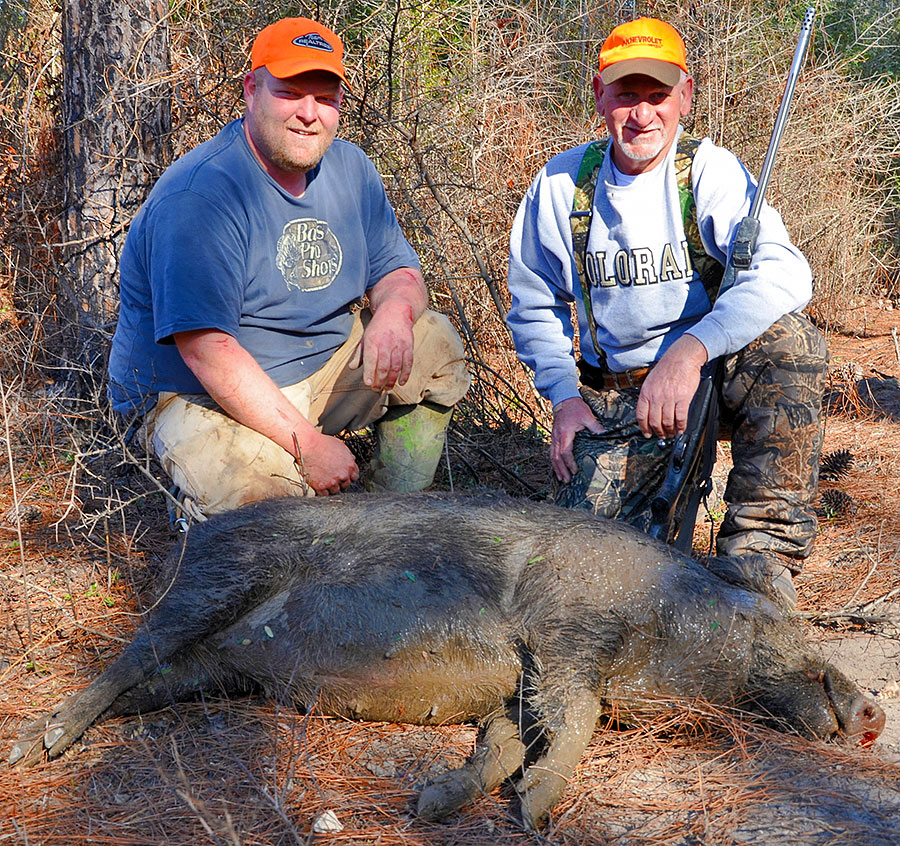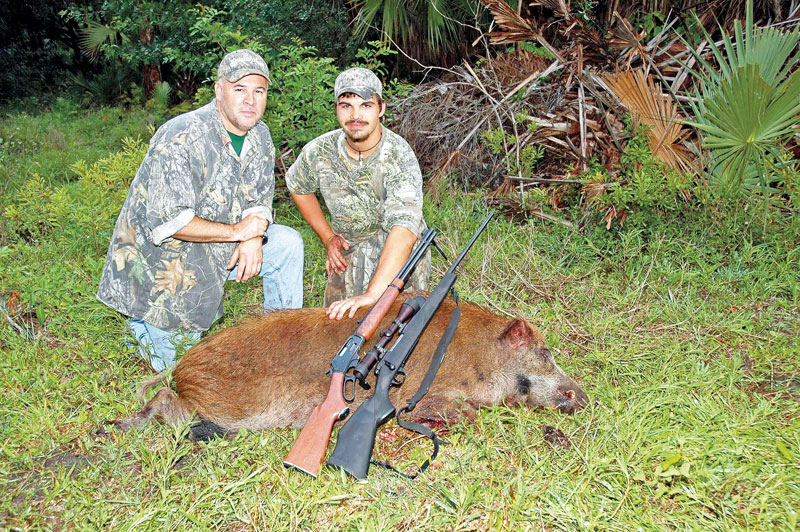
Many hunters consider February almost a dead month since most seasons either ended, or they soon will. Turkey season won’t start for weeks.
However, some hunters love the period between the end of deer season and the beginning of turkey season. February and early March probably offer hunters the best time to put some wild pork in the freezer and enjoy hunting one of the largest and most dangerous animals in Louisiana. But it’s not easy.
“Between the end of deer season and the beginning of turkey season is a great time to hunt feral hogs,” said Ryan Mareno, a hog hunter associated with Calcasieu Rod & Gun (318-675-9114, Calcasieurodandgun.com) in Lake Charles. “Vegetation dies off and most foliage drops off the branches in the winter so people can see better for longer distances at that time.”
A million feral hogs
Feral hogs can live almost anywhere. They occupy every parish and every habitat type in Louisiana. The state considers feral swine outlaw game and encourages people to kill as many as they can.
“We have roughly a million feral hogs in Louisiana,” said Dr. Jim LaCour with the Louisiana Department of Wildlife and Fisheries. “Pigs can rapidly overpopulate an area. Due to the high productive rate of hogs, people must kill at least 70 percent of the pig population in a given area every year just to maintain the population status quo.”
A feral sow can begin breeding when she reaches six months old. She can give birth to two litters per year, each with four to 14 piglets with an average of six. By the time she drops her second litter, her first daughters begin giving birth. In Louisiana, their numbers are out of control and little has been done to stop it.
“Hogs breed all year long,” LaCour said. “However, in our studies, we’ve seen a peak in breeding around January 1 and July 1. A sow will carry for three months, three weeks and three days. A sow that breeds around Jan. 1 will be giving birth in late March or early April.”
Sows commonly travel in groups called “sounders” with two or more large sows and multiple piglets. Highly protective of their young, sows vigorously drive off most intruders. Sometimes, a brave coyote or bobcat snatches a piglet, but few animals want to tangle with an adult pig.

“Sows fiercely protect their babies so piglets have a very high survival rate,” LaCour said. “Once piglets are out of the stripe stage, they really don’t have any predators other than humans. A bear might occasionally take one or maybe a large alligator. If the sow is killed, coyotes or bobcats might pick off some piglets.”
Rabbit, squirrel and quail seasons run through February. On most wildlife management areas, people can kill wild swine during any open season if using weapons and ammunition legal for that species. Some public lands offer special hog seasons.
“The Florida Parishes are loaded up with hogs,” LaCour said. “They are even in the South Louisiana marshes. We even have some in urban areas like the outskirts of New Orleans. We have them right here in Baton Rouge.”
On private lands, people can kill feral hogs without limit all year long, day or night. Deer hunters kill many pigs from stands overlooking feeders. When whitetail season ends and people quit feeding deer, pigs lose that daily food source. After deer season ends, people can keep their feeders operating for pigs as long as they don’t hunt turkeys anywhere near a feeder.
Something they can smell
For pigs, some people sour their corn by adding beer, Kool-Aid or other ingredients that hogs can easily smell. To keep pigs in range longer, some people dig holes about two feet deep and pour sour corn into the holes. That forces pigs to work for their goodies rather than just vacuuming up kernels off the ground.
A “pig pipe” can also keep hogs in place for hours. Fill a section of PVC pipe with corn. Cap one end and add a screw cap to the other end. Drill holes in the pipe just big enough for one corn kernel to barely slip out. To get at the corn, pigs knock the pipe around.
On public lands, hunters cannot bait, so look for any natural foods. Omnivorous hogs eat practically anything. Their diet might include grass, roots, berries, tubers, fruit, bulbs, mushrooms, agricultural crops, insects, snails, grubs, earthworms and carrion. Pigs love eggs and eat the young of ground-nesting birds like quail and turkeys. Hogs eat anything they can catch, including whitetail fawns.

“In February, pigs spend a lot of time looking for food,” Mareno said. “People start finding them in places where they might not have been for the last few months. I look for water sources or marshy areas. Pigs like moist, soft mud where they can root around for food.”
As winter progresses, natural foods become scarce so hogs must spend more time roaming around looking for something to eat. The state plants food plots on some WMAs for deer. After deer season ends, food plots make great places to look for pigs.
“By the end of deer season most of the hard mast is gone, so hogs start looking for invertebrates, particularly earthworms and grubs,” LaCour said. “We’ve done stomach contents studies on feral pigs. Often, their stomachs will have one-third acorns and two-thirds earthworms in it. They eat anything else they can catch, like frogs, lizards, amphibians and crawfish. In the Louisiana marshes, pigs eat crabs.”
Sportsmen who can’t wait for hogs to come to them go to the pigs. Not fearing an attack by predators, adult hogs concentrate more on food than wariness. Since so many pigs breed in early January, many give birth in late March or April, making that an outstanding time to stalk pigs.
Stalk slowly
When stalking hogs, move slowly, just a few yards at a time. Face into the wind. Hogs can easily spot movement and pick up scents. Stop periodically to scan and listen for squeals, grunts, rustling or other sounds. Young piglets make considerable racket. Try calling with low grunts. A squeal indicates a warning or distress.
“Stalking in early spring can be a very good technique for hunting hogs,” Mareno said. “Pigs are very smart. Hunters need to be on their ‘A’ game. Pigs don’t see extremely well, but their sense of smell and hearing are phenomenal. For stalking pigs, stay downwind and move super slow and methodical. Keep any cover between the hunters and the pigs, especially when stalking in daylight.”
As the weather warms, farmers start planting crops. Feral hogs soon come to dig up the seeds. Hogs root up the soil so that it almost looks like a roto-tiller plowed the ground. Herds of wild pigs can devastate crops. They also destroy gardens, ravage fruit and nut orchards and consume anything else they can find.

“In pastures, feral hogs graze on rye grass just like cattle,” LaCour said. “They graze for four or five hours and then lay up the rest of the day with their stomachs as big as basketballs and full of grass.”
According to the U.S. Department of Agriculture, feral pigs cause more than $2.5 billion annually in damage to crops, livestock and pastures in the nation. LSU did a survey in 2022 that said wild hogs cause about $91 million in damage annually to agricultural lands just in Louisiana. Pigs also destroy wildlife habitat and can displace native animals such as white-tailed deer.
Because feral pigs breed so prolifically and cause so much damage, many landowners welcome, even encourage, sportsmen to shoot all the hogs they can on their properties. Making acquaintances with landowners could open access to thousands of acres for hunting.
“Hunters must build relationships with landowners,” Mareno said. “Most people won’t let just anybody come onto their land and start shooting. Get to know the landowners and build a rapport with them. A big thing with landowners is gates. Make sure to close them.”
Many landowners lease land to deer hunters. After deer season ends, landowners might let people come on their properties to hunt hogs and coyotes. Louisiana sportsmen can legally shoot feral hogs, coyotes, armadillos, nutria and beavers at night on private lands all year long.
“Hunters must call the sheriff’s office of the parish where they plan to hunt within 24 hours of going out to hunt pigs at night or immediately upon shooting one,” LaCour said. “Some people put together small groups of hunters and get permission to hunt private properties at night. Some of these groups kill more than a thousand hogs a year.”
Mareno gained access to several properties in western Louisiana. He drives around at night while hunters scan with thermal optics to detect heat signatures. The cardinal rule of night hunting, always positively identify the target. Even with thermal optics, a large pig might look like a small calf. If in any doubt, don’t pull the trigger.
A growing number of people are also beginning to trap hogs, and that has been largely effective.
Day or night, people who kill hogs do the state’s other wildlife and landowners a favor. Plus, they can put some delicious meat in the freezer and enjoy great times while doing it.

It all started with Hernando de Soto
Native to Eurasia, pigs first came to the New World with European explorers, possibly as early as 1498.
The Spaniard Hernando de Soto landed near present-day Tampa, Fla. in 1539. He brought 200 domestic pigs to feed his troops as the expedition wandered across what would become the southeastern United States. Inevitably, some swine escaped into the wilds. Their descendants now number in the millions.
With no refrigeration in those days, ships commonly carried pigs to feed the crews. European sailors frequently released hogs on Caribbean islands to provide a steady source of fresh meat. With few or no natural predators, pigs flourished.
Castaways, marooned pirates and others who found themselves living on small Caribbean islands killed hogs to eat. They cut meat into strips and placed them on wooden racks called “buccans” to slowly dry over fires. These jerky makers became known as “buccaneers.” When not chasing hogs or drying meat, many of these people raided passing ships, giving a second meaning to the word buccaneer!
Our word “jerky” comes from the Spanish word “charque,” a corruption of the native word “ch’arki,” which means “to cut things into long strips” or “to dry meat.” Prepared this way, meat could last a long time in the tropical heat.
